Race Car Telemetry Systems: 7 Powerful Benefits in 2025
The Technology That’s Changing Motorsport
Race car telemetry systems are specialized data communication tools that transmit real-time performance information from a racing vehicle to the pit crew, engineers, and team strategists. These systems serve as the nervous system of modern motorsport, providing critical insights that can make the difference between victory and defeat.
What is a Race Car Telemetry System?
- Definition: A hardware and software solution that collects, transmits, and analyzes vehicle performance data in real-time
- Purpose: Enables data-driven decision making for race strategy, setup optimization, and driver coaching
- Components: Sensors, data acquisition unit, transmission system, and analysis software
- Connectivity: Available via WiFi/Bluetooth (short-range), Cellular 4G/5G (global), or Radio Frequency (track-specific)
Race car telemetry has evolved from simple lap timing to comprehensive systems that monitor everything from engine parameters to driver inputs. Modern systems like the Bosch FM 40, RaceCapture/Pro MK4, SPAA05-RCT, Control TLM-P1 Evo, and Next Solution 4G MK3 offer varying levels of sophistication to match different racing needs and budgets.
“The racing experience will become like a video game for anyone at the race track,” notes one manufacturer, highlighting how telemetry is changing not just competition but also fan engagement.
For teams, telemetry provides the critical ability to make informed decisions during a race rather than relying on gut instinct. Whether it’s monitoring engine temperatures to prevent failure, analyzing braking patterns to improve lap times, or calculating fuel strategy for an endurance event, telemetry gives teams their secret weapon on track.
From grassroots racers using basic systems for personal improvement to professional teams leveraging advanced cellular networks for global data access during 24-hour endurance races, telemetry has become an indispensable tool in the competitive arsenal.
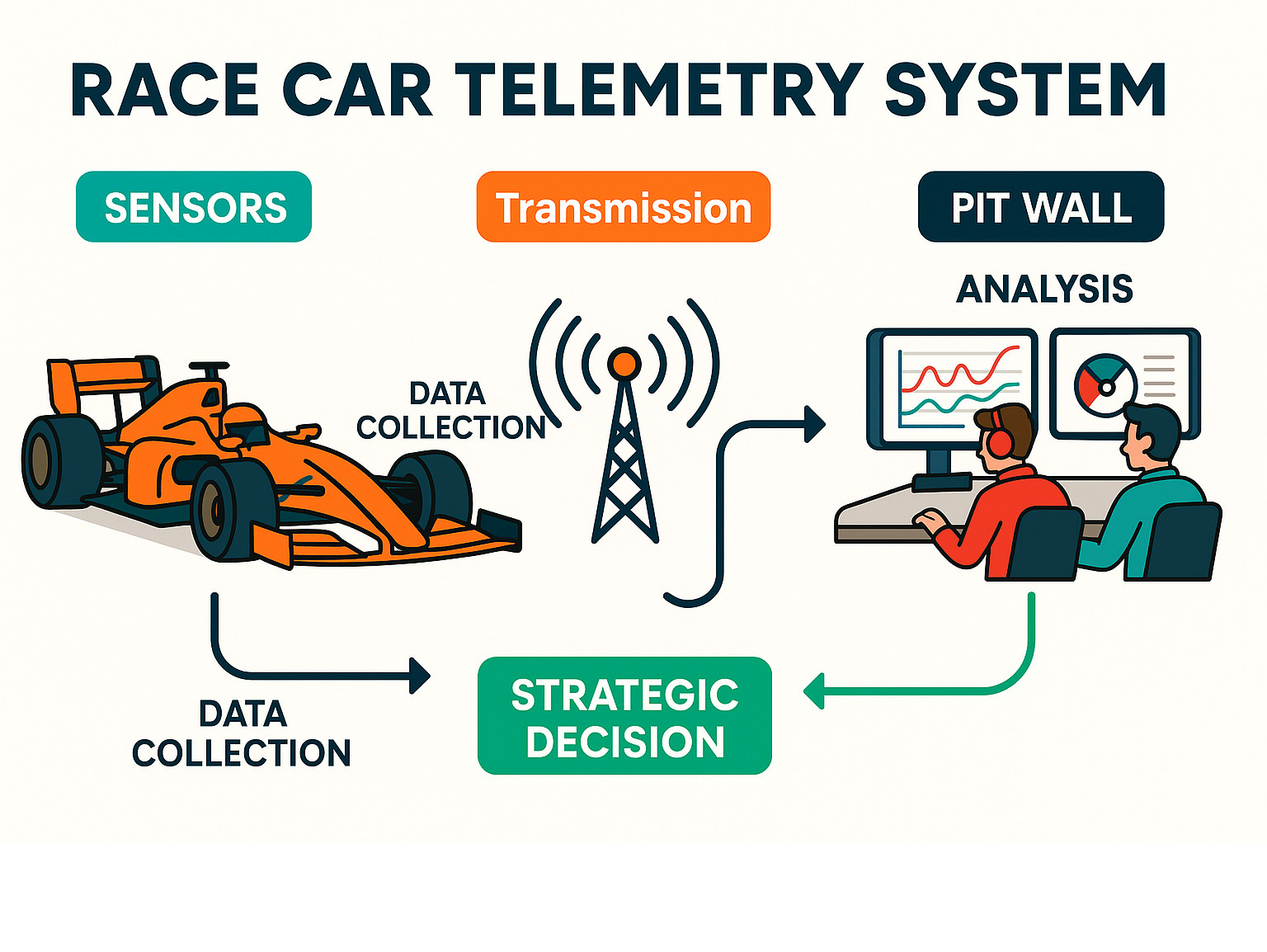
Key race car telemetry systems vocabulary:
– race car driver career path
– race car suspension tuning
How Race Car Telemetry Systems Work
Race car telemetry systems transform modern motorsport by creating a digital bridge between car and pit wall. Think of them as your car’s nervous system – constantly sending vital information to your team while you focus on driving at the limit.

At the heart of every telemetry setup is data acquisition. Your race car isn’t just a mechanical beast – it’s a rolling data center. Dozens (sometimes hundreds) of sensors monitor everything happening in real-time. These sensors connect through a CAN-bus network – the same technology in your street car, but boostd for racing.
The brains of your car’s sensing network include some impressive tech. GNSS modules track your position with incredible accuracy – top systems like the RaceCapture/Pro MK4 use four satellite constellations (GPS, GLONASS, BeiDou, Galileo) to pinpoint you within 2.5 meters at up to 25 times per second.
Your car’s IMU sensors work like a digital inner ear, measuring g-forces and movement in six directions. They tell your engineers exactly how the chassis is behaving through every corner. Meanwhile, engine sensors keep tabs on temperatures, pressures, and fuel flow, while chassis sensors monitor everything from suspension travel to brake pressure.
Race Car Telemetry Systems: Signal Path Explained
Getting all this data from your speeding race car to your team isn’t as simple as sending a text message. The journey happens in milliseconds through several critical steps.
First comes sampling and collection. Different sensors work at different speeds – engine data might be sampled 1000 times per second, while your position updates 5-25 times per second. This data gets temporarily stored in buffers to prevent loss during momentary connection hiccups.
Transmission happens through three main technologies. Radio frequency (RF) systems like the Bosch FM 40 operate in the 430-470 MHz range with transmission power up to 10 watts – powerful enough to cover nearly any track. WiFi/Bluetooth connections work for short-range, high-bandwidth needs. For teams racing internationally, cellular networks (4G/5G) provide global coverage through systems like the Control TLM-P1 Evo.
Surprisingly, cellular telemetry doesn’t burn through data. The RN Live Telemetry Modem uses about 30 MB per hour – that’s less than streaming a single song on Spotify. Even for a 24-hour endurance race, you’d only use about 720 MB.
Error correction technology ensures your data arrives intact, even in the noisy radio environment of a busy racetrack. Once received, powerful software transforms these raw numbers into actionable insights for your team.
Real-Time Benefits for Teams & Drivers
The magic of race car telemetry systems happens when raw data becomes winning strategy.
Real-time telemetry transforms how teams make decisions. Rather than guessing about fuel levels or tire wear, engineers see exactly what’s happening and can make perfect pit stop calls. Predictive lap timing shows whether you’re gaining or losing time while you’re still driving. If something’s going wrong mechanically, your team can alert you before a small issue becomes a race-ending failure.
For developing drivers, telemetry is like having a coach riding shotgun. Your race engineer can provide immediate feedback on braking points, racing lines, and throttle application while you’re still on track – dramatically accelerating your learning curve.
As one race engineer using the Control TLM-P1 Evo system put it: “We had coverage around the entire track – something NONE of us…have ever experienced.” This continuous data flow is changing how teams approach race weekends, from club racing to professional endurance events.
From the moment the green flag drops until the checkered flag waves, race car telemetry systems give you the competitive edge that can make the difference between standing on the podium or watching from the sidelines.
Key Components & Data Streams You’ll Monitor
When you dive into race car telemetry systems, you’ll quickly find they’re like having X-ray vision into your car’s performance. These systems reveal what’s happening under the hood and on the track in ways that were impossible just a few years ago.
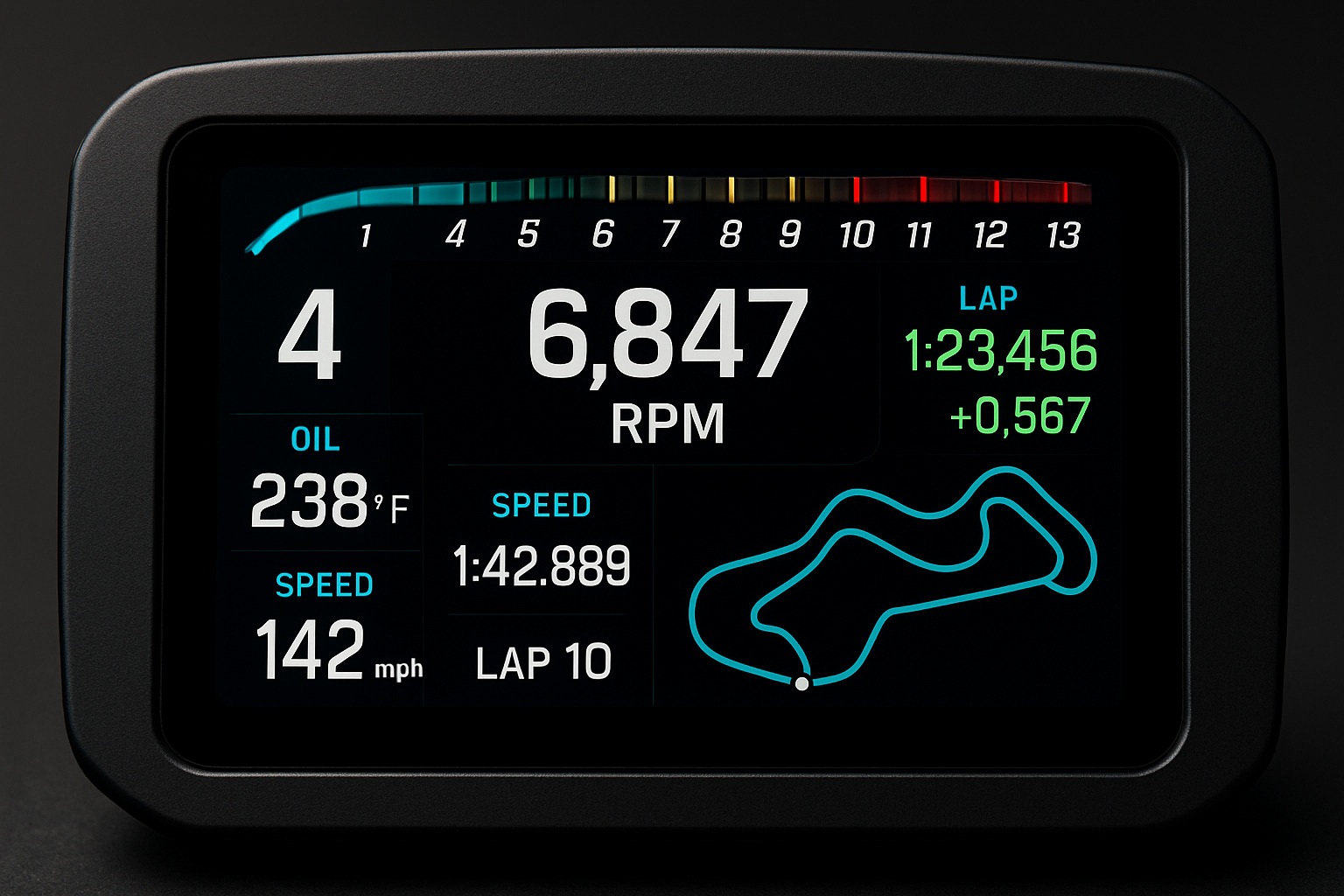
Think of your race car as a patient in an ICU – you’ll be monitoring its vital signs constantly. The engine parameters tell you the heart of your machine is healthy. You’ll keep tabs on RPM and power output to verify the engine is performing as expected, while watching temperature readings at critical points like cylinder heads, oil, and water to prevent the kind of overheating that ends races prematurely.
Pressure readings are equally crucial – that oil pressure dropping? It might be your early warning before catastrophic engine failure. And in the strategy game, real-time fuel consumption data transforms how you plan pit stops. No more guessing when you’ll run dry!
Your chassis and vehicle dynamics data is where the rubber literally meets the road. Suspension travel measurements show exactly how your setup is handling the track’s bumps and corners. When a driver complains about understeer, you can see it in the steering angle data rather than just taking their word for it.
I remember talking to a race engineer who told me, “Before telemetry, we’d argue with drivers about their braking points. Now we can see exactly where they hit the pedal and with how much force.” That brake pressure and balance data is gold for optimizing stopping power. And those g-force readings? They reveal the true cornering capability of your car and the effectiveness of your aero package.
Position and timing data has revolutionized racing strategy. Modern GPS position tracking is accurate to within 2.5 meters with high-end systems, showing precisely where the car is on track. Combined with speed measurements and lap and sector times, you can make real-time comparisons against previous laps or competitor benchmarks. The predictive lap timing feature is particularly helpful – it’s like seeing into the future of your lap time based on current performance.
Perhaps most fascinating is watching the driver inputs. You can see the throttle position percentage throughout the lap, revealing where drivers are hesitant or overconfident. Brake application data shows timing and intensity of braking events – often exposing where time is being left on the table. Gear selection and steering inputs complete the picture of driver technique, showing everything from smooth operators to those manhandling the car.
Core Hardware Inside Race Car Telemetry Systems
The beating heart of these systems is built to withstand the brutal environment of motorsport while delivering reliable data.
The transmitter or modem is command central – processing and sending data from your vehicle to the pit wall. Systems like the Bosch FM 40 operate in the 430 to 470 MHz range with impressive receiver sensitivity, while cellular options like the RN Live Telemetry Modem pack serious capability into a compact package weighing just 307g. The latest Control TLM-P1 Evo even features three simultaneous cellular connections with 5G capability – ensuring your data gets through no matter what.
Antenna selection and placement can make or break your telemetry setup. Your GPS/GNSS antennas need a clear view of the sky, typically mounted at the highest point of the vehicle. Cellular antennas often find their home inside the windshield area, while RF antennas require careful positioning to maximize range and minimize interference.
Most systems don’t just transmit data – they record it onboard too. The data logger component in systems like the RaceCapture/Pro MK4 supports up to 32GB SDHC cards, perfect for capturing every detail during those grueling endurance events. Smart systems will buffer data during transmission gaps and automatically upload it when connection is restored – no data left behind!
Power management might not be sexy, but it’s essential. Most systems accept a 9-20V input range to accommodate different vehicle electrical systems. The RT LIVE system, for example, sips just 1A when operating and a mere 15mA in sleep mode. Advanced systems include auto-sleep features that conserve power when the car isn’t moving.
All this sophisticated tech needs protection, which is why the rugged housing is engineered for extremes. Professional systems like the Next Solution 4G MK3 feature IP67 dust and water resistance, operating temperature ranges from -20°C to +70°C, and mounting systems designed to absorb the constant vibration of a race car at speed.
What the Data Tells You After the Checkered Flag
While real-time telemetry gives you immediate tactical advantages, the post-race analysis is where you’ll find the biggest performance gains.
Lap delta analysis becomes your treasure map to faster times. By comparing laps sector-by-sector or even corner-by-corner, you’ll see exactly where time is being gained or lost. You’ll spot consistency issues across multiple laps, measure the effects of tire degradation over a stint, and quantify the impact of those setup changes you made before the session.
Breaking the track into segments through sector analysis helps identify specific areas for improvement. You’ll see entry, apex, and exit speeds for each corner, evaluate braking points and efficiency, analyze acceleration zones and traction utilization, and assess line selection and positioning. One team I spoke with found half a second just by analyzing a single hairpin turn’s data!
For driver development, telemetry provides objective feedback that cuts through excuses and ego. Drivers can see where they need smoother throttle and brake application, more consistent racing lines, better use of available grip, and more efficient energy management – especially important in hybrid/electric racing series.
Engineers use these data trends to refine vehicle setup with precision. They can fine-tune suspension tuning based on actual load data rather than guesswork, make aerodynamic adjustments informed by speed traces, optimize differential settings for specific corner characteristics, and dial in brake bias based on measured stopping distances and stability.
As one team using the Control TLM-P1 Evo system noted after winning multiple 24-hour races at Le Mans, Spa, Daytona, and Nürburgring: “The support from Control is second to none.” This highlights how the combination of sophisticated hardware and intelligent analysis creates a winning formula that’s changing modern motorsport.
Comparing Leading Telemetry Technologies & Connectivity Options
When it comes to choosing a race car telemetry system, understanding your connectivity options can make or break your racing experience. Think of it as picking the right tire for different track conditions – each technology has its sweet spot where it performs best.

Let’s break down your options in a way that makes sense for your racing program and budget.
WiFi and Bluetooth
Picture yourself at a track day with your laptop open in the pit lane. WiFi and Bluetooth systems shine in these scenarios.
These systems offer impressively high bandwidth – with RaceCapture systems delivering up to 50 Hz sample rates that capture every nuance of your car’s performance. The best part? There’s no licensing paperwork to wade through, and setup is typically as simple as connecting your phone to your home network.
The downside? Range is limited to about 100-300 meters, and just like when everyone’s on the coffee shop WiFi, crowded pit environments can create interference. If you need to track your car around an entire circuit, you’ll find yourself with data blackouts as soon as your pride and joy disappears around the first corner.
Best for: Weekend warriors, testing sessions where you’re working on specific corners, and racers watching their budgets.
Cellular (4G/5G)
Remember how amazing it was when you could suddenly stream video on your phone anywhere? That’s the same game-changer that cellular telemetry brings to racing.
With systems like the RaceCapture/Pro MK4 pumping data at up to 10 Hz over 4G LTE, you can monitor your car from anywhere on track – or even from your team’s headquarters across the country. The global coverage means your endurance team can have engineers working remotely during those grueling 24-hour events.
The data costs might sound scary at first, but they’re surprisingly reasonable – the RN Live system uses only about 30 MB per hour, less than streaming a song. The trade-off is slightly higher latency than direct RF links, and you might face connectivity challenges at packed events when everyone’s posting to Instagram.
The Control TLM-P1 Evo represents the cutting edge here as the world’s first 5G motorsport telemetry device. With three simultaneous cellular connections, it’s like having triple redundancy for your critical race data.
Best for: Club racing teams, endurance events where you need constant monitoring, and international racing programs that need to keep everyone connected.
Radio Frequency (UHF/VHF)
This is where the pros play. RF systems like the Bosch FM 40 are purpose-built for the demanding environment of top-tier motorsport.
With transmission power up to 10W, these systems achieve nearly 100% coverage on most tracks, even in the electromagnetic soup of a major race weekend. The SPAA05-RCT system can reach up to 5 km, ensuring you never lose touch with your car.
The reliability comes with some problems, though. You’ll need frequency licensing in most regions (paperwork alert!), and bandwidth is more limited – the Bosch FM 40 operates at either 9.6 or 19.2 kbps. Setup requires more expertise, particularly with antenna positioning, and your wallet will definitely feel the investment.
Best for: Professional teams where data reliability can’t be compromised, series with standardized telemetry requirements, and applications where milliseconds matter.
Hybrid Solutions
Smart teams don’t put all their eggs in one basket. Many modern systems offer multiple connectivity options:
The RaceCapture/Pro MK4 combines WiFi, Bluetooth, and optional 4G LTE to give you flexibility. Some teams use RF for critical real-time data like engine temperatures, while using cellular connections for bandwidth-hungry video feeds. Having redundant systems means you’ll still capture data even if one transmission method decides to take a coffee break.
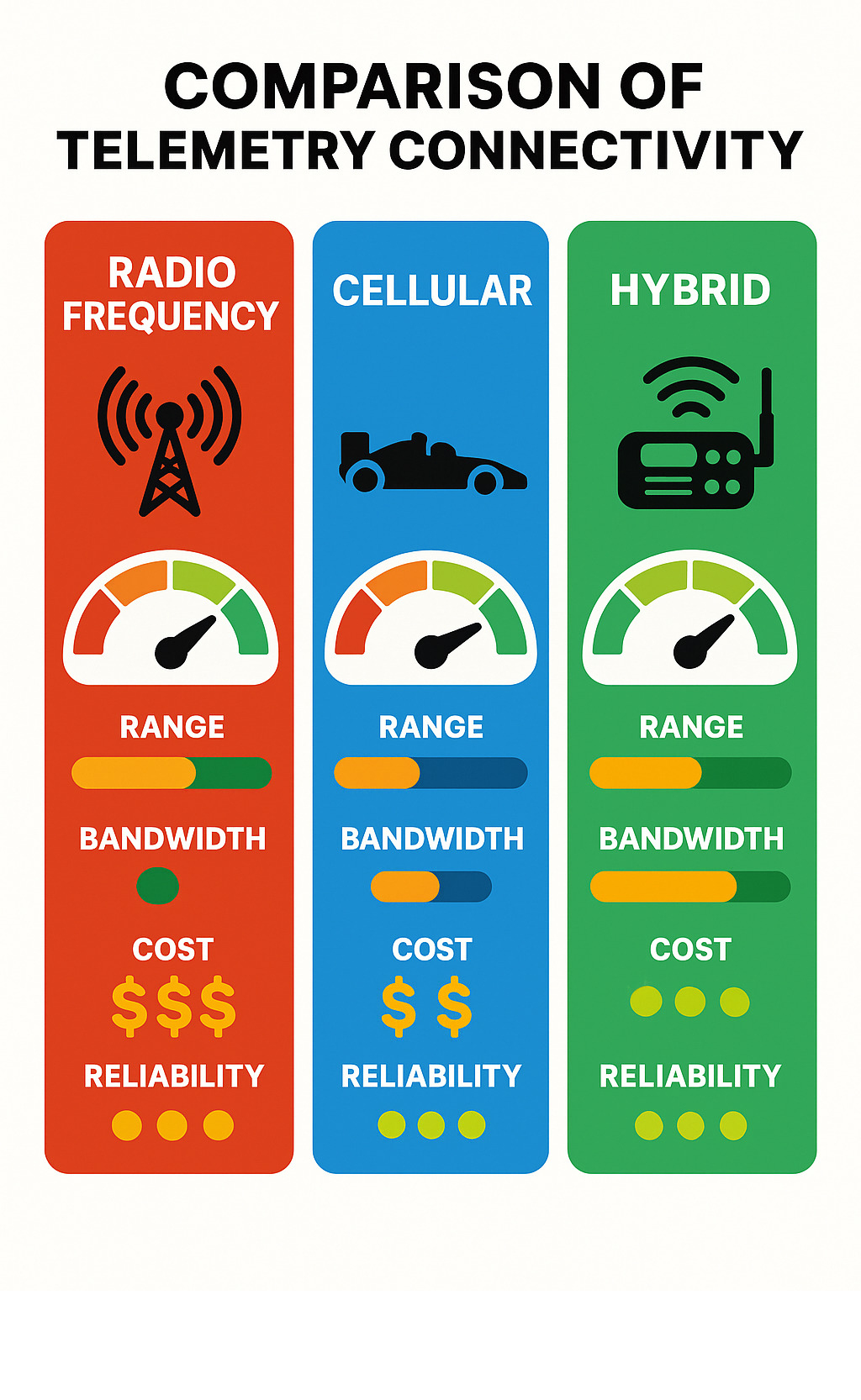
Choosing the Right Race Car Telemetry Systems for Your Budget
You don’t need a Formula 1 budget to benefit from telemetry. There’s something for every level of motorsport:
Entry-Level (Under $1,000)
If you’re just getting started, the RaceCapture/Track MK3 offers WiFi/Bluetooth connectivity, GPS lap timing, and basic sensor inputs at a price that won’t force you to sell your trailer. The SPAA05-RCT Lite delivers professional-grade telemetry for €990 with impressive range.
For the technically inclined, DIY open-source options exist where enthusiasts repurpose drone telemetry hardware like OpenHD combined with Arduino controllers. It’s not plug-and-play, but the price is right.
Mid-Range ($1,000-$5,000)
Step up to the RaceCapture/Pro MK4 and you’ll enjoy dual CAN bus support, 8 analog inputs, cellular options, and extensive customization. The Race Technology RT LIVE offers browser-based telemetry at 5 Hz for £499 per unit, while the Next Solution 4G MK2/MK3 provides robust cellular telemetry with global SIM support and IP67 protection against the elements.
Professional ($5,000+)
At the top end, the Bosch FM 40 delivers the reliability demanded by top-tier teams. The Control TLM-P1 Evo brings 5G technology to motorsport with a proven track record in winning multiple 24-hour races at Le Mans, Spa, Daytona, and Nürburgring. For €5,500, the SPAA05-RCT-VID Lite combines telemetry with video transmission for comprehensive race monitoring.
When considering the return on investment, telemetry isn’t just a cool toy – it’s a performance tool that can identify where you’re losing those crucial tenths, help prevent expensive engine failures, accelerate driver development, and sharpen your team’s strategic execution.
Future Trends: 5G, AI & Cloud Analytics
The telemetry world isn’t standing still – it’s accelerating faster than your car on fresh slicks.
5G connectivity is already making waves with the Control TLM-P1 Evo. The near-zero latency means engineers see data almost as it happens, not seconds later. The increased bandwidth supports richer data streams, including high-quality video alongside traditional telemetry.
Artificial intelligence and machine learning are beginning to transform how we use telemetry data. Imagine systems that can predict component failures before they happen, suggest setup changes based on driver inputs and track conditions, or automatically identify where your driver could find those elusive extra tenths.
Edge computing – processing data on the car before transmission – is making systems smarter and more efficient. By analyzing data at the source, these systems can send only the most relevant insights, reducing bandwidth needs while improving reliability.
Cloud-based analytics are taking telemetry beyond the pit wall. With centralized data repositories accessible via standard web browsers, engineers can support your team from anywhere in the world. Integration with simulation data means your virtual testing directly informs your real-world racing.
Bosch, with its 44,000 software engineers and focus on IoT and AI solutions, is pioneering these developments. Their cross-domain connectivity solutions are likely to shape the next generation of innovative racing technology.
As these technologies mature, expect telemetry systems to become more accessible, powerful, and integrated with the broader digital ecosystem of motorsport. The data-driven racing revolution is just getting started, and at Car News 4 You, we’re excited to help you steer this rapidly evolving landscape.
Installation, Integration & Best Practices
Properly installing and configuring race car telemetry systems is crucial for reliable operation in the demanding environment of motorsport. Here’s how to ensure your system performs optimally.
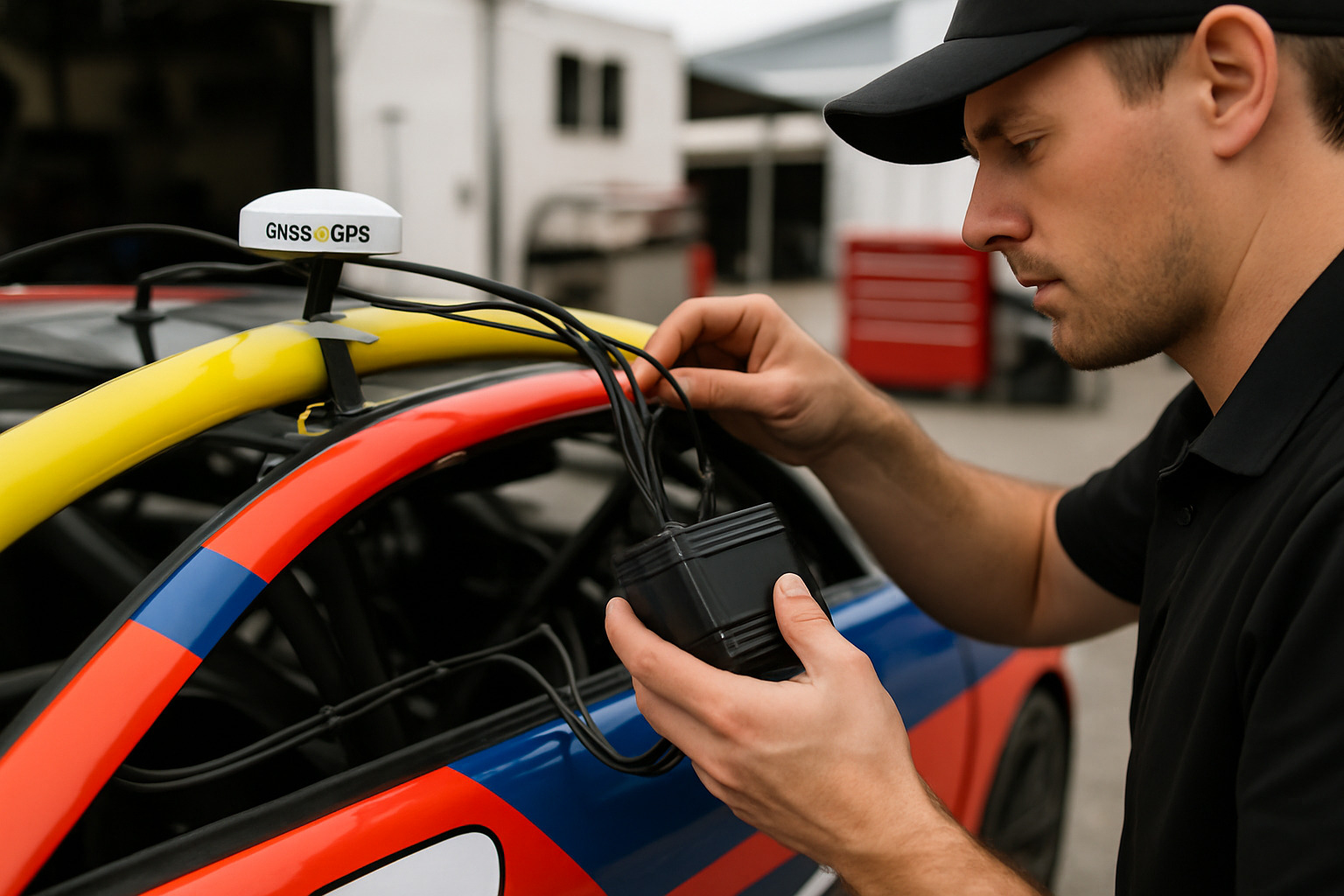
When it comes to antenna placement, think of it as giving your telemetry system the best possible “view” of the world. Your GNSS/GPS antennas need a clear line of sight to the sky, so mount them at the highest point of your vehicle—typically on the roof or roll cage. The RaceCapture/Pro MK4’s GNSS module, for instance, works best when it has an unobstructed connection to satellite signals.
For cellular systems like the RN Live Telemetry Modem, attach the window antenna to your windshield using the provided suction cups. Just be sure to keep it away from metal components that might block signals. With RF antennas, such as those used with the Bosch FM 40, vertical mounting on a conductive plane creates the optimal radiation pattern. And remember—keep those RF cables under 2 meters to minimize signal loss.
Cable routing might seem mundane, but it can make or break your telemetry system’s reliability. Think of your race car as a noisy concert hall—you want to keep your sensitive audio equipment (signal cables) away from the speakers (ignition systems and alternators). Use shielded cables where appropriate, especially for those delicate analog sensor inputs. Secure everything to prevent movement during high-G cornering, and be mindful of sharp edges that could slice through your cables during a race.
Power considerations are often overlooked until they cause problems. Your telemetry system needs clean, consistent power to function properly. Connect to a switched power source that’s active when the engine is running. Some teams even add a small backup power supply for critical systems—think of it as insurance against momentary power hiccups. The RT LIVE system needs 9V-20V input and draws about 1A when operating. If your race car sits unused between events, use a switched power supply to prevent battery drain, as even sleep mode draws a small current (15mA for the RT LIVE).
Before hitting the track, make sure your firmware and software are properly configured. Always update to the latest firmware to benefit from bug fixes and new features. When setting sampling rates, higher isn’t always better—if it exceeds your transmission bandwidth, you’ll just end up with data gaps. Configure your buffering parameters to handle those inevitable connection interruptions gracefully. And for cellular systems, check that your data plan can handle your usage needs (the RN Live system uses approximately 30 MB per hour).
Sensor calibration is the difference between useful data and misleading information. Zero your accelerometers on a level surface before each race weekend. Calibrate pressure sensors against known reference values. Verify temperature readings against secondary measurement devices. And make sure your CAN bus parameters match your ECU’s specifications perfectly.
In today’s connected world, data security matters more than ever. Use encrypted transmission where available, especially for cellular systems. Change those default passwords on all components of your telemetry system. Be mindful of who has access to your data streams, particularly at shared events where competitors might be lurking. And regularly back up your configuration files and historical data—you’ll thank yourself later.
Don’t forget about regulatory compliance, which varies by region. RF systems like the Bosch FM 40 (operating in the 430 to 470 MHz range) often require frequency licensing in most countries. Cellular systems need properly registered SIM cards for the countries where you’ll be racing. And some racing series have specific rules about what telemetry is allowed during competition, so check the rulebook before investing.
For more insights on cutting-edge racing technology integration, check out our guide to Innovative Racing Technology.
Integrating Telemetry with Existing Dash & ECU Systems
Modern race car telemetry systems are designed to play nice with your existing automotive electronics, from factory ECUs to specialized racing gear.
AiM data systems are widespread in motorsport, and many telemetry solutions offer seamless integration. The PodiumConnect MK2, for example, is specifically built to work with existing AiM systems. Data channels can be mapped directly from AiM’s protocol to telemetry streams, giving you both local data logging and remote telemetry capabilities in one cohesive package.
If you’re running MoTeC systems, you’re also in luck. CAN bus connections allow telemetry systems to communicate directly with MoTeC ECUs and data loggers. Channel mapping tools help translate MoTeC’s data structure to telemetry formats without headaches. Some systems, like PodiumConnect, are purpose-built to add telemetry capabilities to your existing MoTeC setup.
Race Technology users can improve their data logging with telemetry too. The RT LIVE system extends Race Technology’s platform with cellular connectivity while maintaining the standard RUN file format for compatibility with all Race Technology software. You can view live data at 5 Hz in a browser or bump that up to 10 Hz via the dedicated Live Monitor software.
For those who value flexibility, many modern telemetry systems support open standards. OBD-II connectivity provides basic telemetry from virtually any modern vehicle. CAN bus has become the universal standard, with systems like RaceCapture/Pro MK4 supporting dual CAN 2.0 channels at up to 1 Mbps. Some advanced systems can even read and transmit data from multiple protocols simultaneously.
For the tech-savvy racer, advanced systems offer programming capabilities for custom integration. RaceCapture systems feature Lua scripting that lets you create custom behaviors and calculated channels without needing a computer science degree. As one user noted: “Extensibility through on-board Lua scripting allows custom behavior without embedded programming skills.” This flexibility is gold when integrating with diverse existing systems.
Avoiding Common Pitfalls
Even the best race car telemetry systems can fail if you don’t address these common problems:
Every track has coverage dead zones where signal strength fades. Smart teams map signal strength around the circuit during testing to identify these problem areas before race day. Consider using multiple transmission technologies for critical applications, and configure data buffering to handle temporary connection losses. The Control TLM-P1 Evo tackles this with three simultaneous cellular connections—think of it as not putting all your eggs in one basket.
Heat is the enemy of electronics. Mount your telemetry components away from exhaust systems and other heat sources, and ensure adequate airflow around the main unit. Some systems include temperature monitoring and thermal protection features to prevent damage. The Bosch FM 40 manual specifically recommends mounting “on shock-absorbing material away from engine heat and vibration”—advice worth following for any telemetry system.
For cellular systems, unexpected data costs can give you a nasty surprise. Monitor your data usage during initial testing to establish baselines. Calculate your expected usage for race weekends (RN Live uses about 30 MB per hour), and consider data plans with alerts or caps to prevent overages. Some clever systems offer data compression or selective transmission to reduce bandwidth requirements.
Finally, don’t overlook regulatory licensing for radio frequency systems. Research frequency allocation rules for each country where you’ll be racing, and apply for appropriate licenses well in advance of events. Configure your transmit power to comply with local regulations, or consider cellular alternatives in regions with strict RF licensing requirements.
By addressing these common issues before they become problems, you’ll ensure your telemetry system provides reliable insights when you need them most—in the heat of competition.
Frequently Asked Questions about Race Car Telemetry Systems
What does a telemetry kit cost from entry-level to pro?
Let’s talk money – because let’s face it, that’s often the first question on everyone’s mind when exploring race car telemetry systems!
The price range is quite broad, depending on how sophisticated you want to get. If you’re just dipping your toes into the telemetry waters, entry-level systems like the SPAA05-RCT Lite (around €990) or Race Technology RT LIVE (about £499) will get you started without breaking the bank. These systems give weekend warriors and track day enthusiasts the basic data they need to improve their driving.
Moving up the ladder, mid-range solutions between $1,000-5,000 – like the versatile RaceCapture/Pro MK4 – offer a significant step up in capabilities. You’ll get dual CAN bus support, cellular connectivity options, and the ability to customize the system to your specific racing needs. This is where most serious club racers and semi-pro teams find their sweet spot.
For the professionals who can’t afford to compromise, high-end systems like the Bosch FM 40 or Control TLM-P1 Evo start around $5,000 and can easily climb past $20,000 for complete packages. The reliability and performance advantages these systems offer make them worth every penny for teams where milliseconds and data accuracy truly matter.
Remember though, the initial hardware purchase is just the beginning of your investment. You’ll likely need to budget for monthly cellular data plans, potential frequency licensing fees, additional sensors, software subscriptions, and possibly professional installation. It’s a bit like buying a race car – the purchase price is just your entry ticket!
How is telemetry data protected from hackers or rivals?
In the high-stakes world of motorsport, your data is gold – and just like any valuable asset, you need to protect it from prying eyes!
Modern race car telemetry systems employ several security measures to keep your competitive edge safe. Many systems now use encrypted transmission protocols, especially those relying on cellular or WiFi connections. This scrambles your data in transit, making it much harder for the team in the next garage to sneak a peek at your secret sauce.
RF-based systems like the Bosch FM 40 have a natural security advantage by using dedicated frequencies and proprietary protocols. Without the exact matching equipment and settings, intercepting these signals becomes significantly more challenging.
For cloud-based platforms like Podium, user authentication and permission systems create digital barriers that keep unauthorized users out of your data. Professional teams take this even further by operating completely isolated networks at the track – think of it as building a digital moat around your race operation.
That said, I should mention that no system is completely hacker-proof. The most determined competitors with technical resources could potentially intercept unencrypted wireless transmissions. It’s why you’ll see Formula 1 teams and other top-tier racing operations developing their own proprietary security measures beyond commercial solutions.
As one team engineer once told me with a wink: “In racing, we assume everyone’s trying to see our data – we just make sure what they see isn’t worth seeing!”
Can I add live video without overloading the link?
Adding video to your telemetry feed is like trying to fit a watermelon through a garden hose – it’s all about managing that bandwidth!
While race car telemetry systems typically transmit relatively small packets of numerical data, video is a whole different animal. To put it in perspective, the RN Live Telemetry Modem uses about 30 MB per hour for pure telemetry data, while video can easily consume several gigabytes in that same timeframe.
If you’re determined to have both, dedicated systems like the SPAA05-RCT-VID Lite (priced around €5,500) are specifically engineered to handle this combined workload. These systems make the necessary compromises and optimizations to deliver both data streams effectively.
For most racers, the practical approach involves some creative compromises. You might reduce video resolution and frame rate to squeeze it through your available bandwidth. Many teams use adaptive quality settings that automatically adjust based on signal strength – ensuring your critical telemetry data always gets priority over that crystal-clear cockpit view.
Another smart approach is using separate transmission paths – keeping your mission-critical telemetry data on reliable RF links while sending video over cellular networks. Some clever systems even use triggered recording, only transmitting video during specific events like potential mechanical issues or when you set a personal best lap.
The RN Live system offers a particularly neat solution, with onboard livestreaming that uses the same 4G/LTE connection to send both telemetry and video to multiple endpoints. It’s one of the more seamlessly integrated options out there.
For club racers and weekend warriors, I usually recommend recording high-quality video locally on the car with a GoPro or similar device, while only streaming essential telemetry in real-time. The RaceCapture/Pro MK4 even includes GoPro integration to synchronize your video with telemetry data for post-session analysis – giving you the best of both worlds without overwhelming your connection.
After all, knowing your engine temperature is spiking is probably more important than your fans seeing your facial expression when it happens!
Conclusion
Race car telemetry systems have come a long way from being exclusive Formula 1 technology to becoming valuable tools accessible to racers of all levels. Whether you’re a weekend warrior using the RaceCapture/Track MK3 to shave seconds off your lap times or a professional endurance team relying on the Control TLM-P1 Evo’s 5G capabilities to clinch victory in a 24-hour race, telemetry has firmly established itself as a must-have in modern motorsport.
After diving deep into racing telemetry, here’s what we’ve learned together:
Connectivity matters tremendously in your telemetry journey. WiFi and Bluetooth offer simplicity and work great for short-range applications, while cellular options give you that global coverage you might need for traveling teams. If absolute reliability is your priority – especially for professional applications where every data point counts – RF systems remain the gold standard.
Don’t feel overwhelmed by the complexity of these systems. Even the most sophisticated teams started somewhere. Begin with fundamental measurements that make sense for your racing program, then gradually expand as you become more comfortable interpreting the data. You’ll be surprised how even basic telemetry insights can transform your approach to racing.
The way you install your system makes all the difference. Take time to position those antennas properly, keep cables away from interference sources, and ensure you have clean, reliable power. These seemingly small details often separate successful telemetry implementations from frustrating failures.
If you’ve already invested in data systems like AiM, MoTeC, or Race Technology, prioritize telemetry solutions that play nicely with your existing setup. The best systems extend your current capabilities rather than forcing you to start from scratch.
As your reliance on data grows, so should your attention to security and data management. Your telemetry reveals your competitive secrets – protect them accordingly, especially as you collect more information over time.
The horizon looks incredibly bright for racing telemetry. With 5G networks expanding, artificial intelligence becoming more accessible, and cloud analytics growing more sophisticated, we’re entering an era where telemetry will deliver even deeper insights while becoming more affordable and user-friendly. The integration of these systems with other digital aspects of motorsport will only accelerate in the coming years.
Here at Car News 4 You, we’re passionate about helping you steer the sometimes confusing world of racing technology. Our team understands the challenges you face, whether you’re just starting to explore telemetry or looking to fine-tune an existing setup.
Want to dive deeper into related racing topics? Check out our comprehensive guides on Race Car Suspension Tuning and Innovative Racing Technology, or explore our full collection of resource guides.
In today’s data-driven motorsport landscape, the right telemetry system isn’t just another gadget in your toolbox—it’s the difference-maker that could propel you to the top step of the podium.


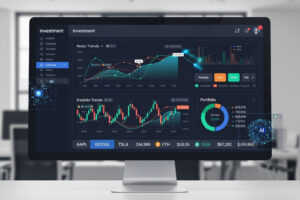





1 thought on “Race Car Telemetry Systems Explained: Your Secret Weapon on Track”
Pingback: The Fast and the Curious: A Guide to Race Car Aerodynamics - Car News 4 You
Comments are closed.